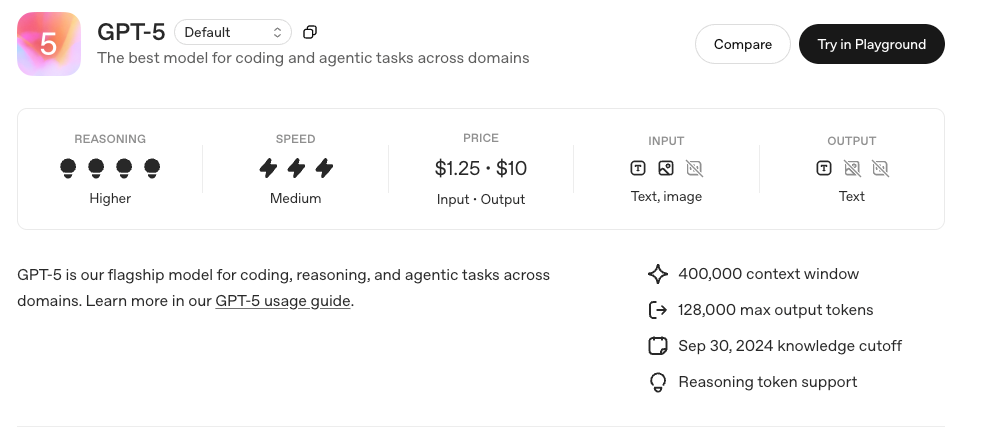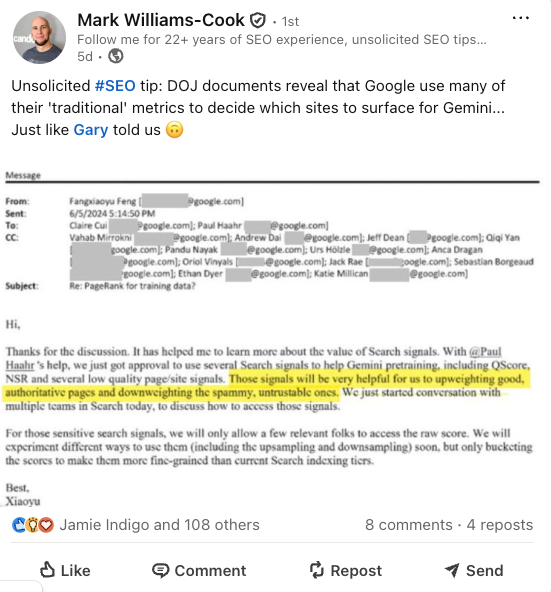GEO and SEO: How to invest your time and efforts wisely

Generative engine optimization (GEO) is the new kid on the block, the hot topic.
SEO professionals and stakeholders want to know: How much should I invest in it in a world where the people writing the checks are a bit skeptical?

In the world of large language models (LLMs) in 2025, that’s a complicated question.
This article breaks down why by covering:
- How LLMs like OpenAI and Gemini currently use search engines.
- What search marketers should assume about where AI is heading.
- The types of executional work that align with GEO.
- What all of this means for prioritization and investment.
How LLMs stay current: Grounding and RAG
One of the fundamental challenges for the creators of LLMs (LLMs) like OpenAI or Claude is timeliness.
Their training data is static, locked to a specific cutoff date.
For example, the GPT-5 model’s knowledge cutoff is Sept. 30, 2024.
It’s more recent than GPT-4o’s cutoff of Oct. 1, 2023, but still not up to the present day.
Updating that training data is extremely costly, and it’s increasingly under public scrutiny – both for the resource-intensive nature of the process and the potential copyright issues it raises.
In my view, these large-scale training updates are becoming less and less likely over time.

So how do OpenAI, Claude, or Gemini keep their answers current?
They use retrieval-augmented generation (RAG), where the model enriches its responses by effectively “browsing” the web. ChatGPT relies on Bing, while Gemini draws from Google.
(There are signs Gemini doesn’t always use live results, but rather cached ones – that’s a whole other article, and one Dan Petrovic has already written smartly about.)

Grounding is a similar concept here, so for this article, we’ll treat it as the same “timely” method, even though there are important nuances in implementation.
What does this mean for SEOs and digital marketers deciding how much to invest in GEO?
Quite simply: we still need to prioritize traditional SEO first. RAG is a limited resource, and research shows:
- Of the 80 million ChatGPT queries analyzed, about 46% triggered ChatGPT search.
- Nearly 90% of ChatGPT search citations matched Bing’s Top 20 results.
It’s also important to note: when ChatGPT cites your brand, it doesn’t just pull from your website. It pulls from sources across the web.
The bottom line: you still need to master traditional SEO fundamentals to rank in LLM-driven search.
If you don’t have the authority to break into the Top 20 results, plus a diversified outreach strategy for press mentions and brand visibility, it will be much harder to surface in generative search.
Dig deeper: SEO vs. GEO: What’s different? What’s the same?
Thinking long term
As a low-risk, forward-looking, brand-focused SEO, you must plan for a future where generative search dominates, driving most traffic and revenue.
At that point, we must assume our websites and digital properties function primarily as enriched data feeds for LLMs.
It’s also critical to clearly define our brand for both Google and Bing, as strong, unambiguous entity signals will only grow in importance.
Optimizing your data infrastructure and strengthening brand signals – through consistent press mentions, directory listings, and owned media – are essential but resource-intensive tasks.
They demand coordination across departments that rarely collaborate and often require dismantling entrenched processes.
Because many businesses hesitate to make these foundational changes, you’ll need to account for the time required to execute the work and the time required to gain stakeholder alignment.
Get the newsletter search marketers rely on.
See terms.
Execution: Technical and brand
The work required to make your website as LLM-friendly as possible falls into two main buckets: technical and brand.
Technical tasks
Implementing thorough schema markup
This is a contentious topic.
LLMs don’t directly use schema markup in their training data (it’s stripped), and in their RAG process, everything is tokenized and likely broken into n-grams.
I’m not suggesting schema markup is a direct way to influence visibility in LLMs.
It’s a vehicle for helping Google and Bing understand:
- Your website.
- Its relationships.
- Its products.
This builds your brand and search engines’ recognition of it, which should improve your visibility in results.
Technical copywriting
On navigational pages – like product collection pages or company listing pages if you’re a marketplace – create technical copy (done via AI with smart prompting if you’re working at scale) that summarizes the available resources.
For example:
- “Our stationery includes 5 A5 dotted journals, 2 N1 blank journals, 25 stickers featuring animals, 4 stickers with curse words (all vinyl for weatherproofing and waterproofing), and 1 lapel pin.”
Notice how direct and technical this is. The clear formatting ties back to dependency hops in natural language processing.
XML sitemaps
A spring cleaning task.
Your XML feeds should be 100% to spec:
- No 404s.
- No 301s.
- No more than 5,000 URLs per sitemap.
- All recommended fields in place.
I’m calling it out specifically because it’s one of the most direct ways for search engines and other bots to see and navigate the full scope of your website.
JavaScript fallbacks
This has always been important but has fallen by the wayside in recent years.
Training data for LLMs is static HTML. For the most part, they don’t render JavaScript.
Make sure to have functional JavaScript fallbacks.
Address technical debt
This will depend on your organization. It could mean:
- Having a clear product sunsetting process.
- Updating the codebase.
- Removing the ghost codebase still sitting on your site from eight years ago that everyone built on top of rather than deleting.
- Migrating from an SPA to a more search-friendly framework.
- Removing deprecated scripts.
- Auditing third-party tags to ensure they’re up to date and still in use.
All of these impact performance.
The technical strength and response time of your website will only grow more important.
Every piece of tech debt is an opportunity to improve.
Dig deeper: A technical SEO blueprint for GEO: Optimize for AI-powered search
Brand tasks
Brand tasks would include things like:
- Creating consistent brand descriptions and implementing them across all platforms.
- Updating your About page to have as much relevant information as possible, such as:
- Founding timeline.
- Founders and leadership profiles.
- Corporate social responsibility initiatives.
- Partners.
- Supply chain.
- Your unique selling proposition.
- Press mentions.
- Awards and other social proof.
- Testimonials.
- A contact form.
- Claiming your Google Knowledge Panel (or monitoring it until it becomes available, then claiming it).
- Planning regular press mentions, doing outreach yourself, or working with a PR company to make it happen.
- Claiming and optimizing your Google Business Profile if you’re a local business.
- Submitting your company for a Wikipedia page once you’ve built enough notability.
Dig deeper: In GEO, brand mentions do what links alone can’t
Making smart investments in SEO and GEO
If there’s only one takeaway, it’s this: keep investing the majority of your time and budget in traditional SEO, while dedicating a smaller portion to technical and brand tasks like those outlined above.
Look closely at the 1-5% improvements you’ve been putting off – things like:
- Correcting the HTML heading hierarchy to match the site’s visual hierarchy.
- Fixing internal links so they point directly to final URLs instead of redirect chains.
- Cleaning up your XML sitemap.
- Removing deprecated libraries and unused WOFF files.
This “spring cleaning” and tech debt cleanup should be a priority.
Add in the brand work as well, since it strengthens traditional search today and also lays the groundwork for an LLM-led search future.
If you don’t already have regular reporting in place for stakeholders and leadership, create it now.
There’s a perception that large language models are evolving rapidly and changing everything at once.
That isn’t entirely true – but we do need to plan.
Establishing a cadence of reporting and education means that when real shifts do happen, your stakeholders will already be aligned and ready to support the work.
Finally, treat GEO/AI optimization as roughly 20% work.
This means building systemic schema layers across your organization and creating structured connections in the machine’s native language – code.
Start with:
- Conversations.
- Proofs of concept.
- Pilot implementations.
Done properly, this work should have no negative impact on your business metrics, and it builds support for more holistic optimization over time.
Going all in on LLM-specific tactics isn’t the best use of your resources today.
Instead, treat it as complementary work – something that strengthens your technical and brand foundation while preparing you for a future where generative search plays a central role.







Recent Comments